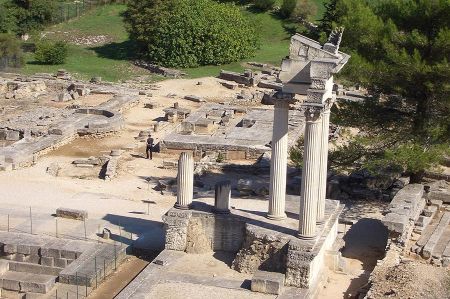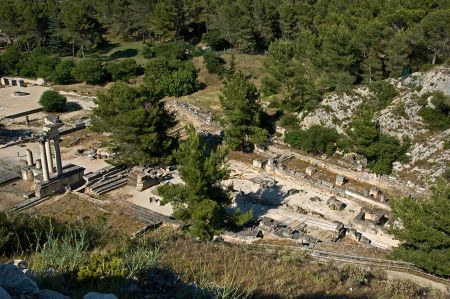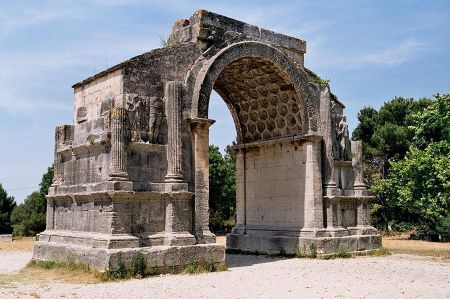Our interest in the Roman period in Marseille had led to initial findings, particularly through the museum in the Centre de la Vieille Charité, although the research was not that easy.
Today we want to set off on a short excursion to Saint-Rémy-de-Provence, a place about 85 kilometres from Marseille, where the ruins of the ancient city of Glanum await us, which only came to public attention again in 1921 through excavations. Since then, it can be rightly said that Glanum has developed into one of the most important archaeological sites from the Roman period in France. More than a century of archaeological research now makes it possible to enjoy the evidence of these exceptional architectural ruins. Located in the heart of the Alpilles massif, the initially Gallic city was subsequently shaped by Greek and later Roman influences.
Founding of the town as an oppidum by Salluviers
 The later town of Glanum was founded by the Salluviers initially as an oppidum or fortress on Mont Gaussier. A dry-stone wall, once surrounded the twenty-hectare site and blocked the pass through the Alpilles. A shrine to the Celtic god Glanis, who is associated with a healing spring, was built in the 4th century BC. By the 3rd century BC at the latest, Greeks had built a trading centre there called "Glanum". Starting from Marseille, Greek influence grew through traders who travelled up the Rhone. They brought with them their alphabet, in which the local Celtic dialect was also written down, and of course their architectural style.
The later town of Glanum was founded by the Salluviers initially as an oppidum or fortress on Mont Gaussier. A dry-stone wall, once surrounded the twenty-hectare site and blocked the pass through the Alpilles. A shrine to the Celtic god Glanis, who is associated with a healing spring, was built in the 4th century BC. By the 3rd century BC at the latest, Greeks had built a trading centre there called "Glanum". Starting from Marseille, Greek influence grew through traders who travelled up the Rhone. They brought with them their alphabet, in which the local Celtic dialect was also written down, and of course their architectural style.
Glanum was already a few centuries old when the Romans verifiably took over control there in the 1st century BC. The Greek agora was converted into a Roman forum in two construction phases, and thermal baths, triumphal arches and temples were built. All of this happened not least because Emperor Augustus elevated the city to the status of a Roman colony. His son-in-law Agrippa is said to have even stayed in Glanum and had a temple built there.
Monuments and functional buildings by the Romans
 But the Romans not only brought beautiful monuments, but also valuable functional buildings. An astonishing dam and an ingenious sewer system were built for the city, which solved the long-suffering problem of regular flooding during rainy seasons. A trapezoidal agora was also built. The Romans took over the shrine and sanctuary, as well as a trinity of local mother goddesses, whom they called Glanicae. They were identified with the matrons. The goddesses Epona and Rosmerta and the god Mercury were also present. The once Greek agora gave way to a Roman forum in two phases.
But the Romans not only brought beautiful monuments, but also valuable functional buildings. An astonishing dam and an ingenious sewer system were built for the city, which solved the long-suffering problem of regular flooding during rainy seasons. A trapezoidal agora was also built. The Romans took over the shrine and sanctuary, as well as a trinity of local mother goddesses, whom they called Glanicae. They were identified with the matrons. The goddesses Epona and Rosmerta and the god Mercury were also present. The once Greek agora gave way to a Roman forum in two phases.
In Augustan times, the city was upgraded to a colony and many monumental buildings were built, including thermal baths, a triumphal arch and various temples. It was probably at this time that the Glanum Dam was built, which supplied the colony with water. A sewer system was also created, which also provided for the drainage of rainwater in the narrow valley.
The impressive arch of Glanum (12.50 m long, 5.50 m wide, 8.60 m high) dates from the late reign of Augustus (27 BC-14 AD), making it one of the oldest in Gaul. It shows Gallic prisoners being led away in chains by the victorious Romans. Its upper part was redesigned in the 18th century in the form of a gabled roof and covered with stone slabs to protect it from rain, giving it its somewhat odd shape.
Next to the triumphal arch is the 18-meter-high mausoleum, part of a necropolis outside the city walls. Three brothers with the surname Julius built it in memory of their parents. It dates from 35 BC. AD and, according to the inscription, commemorates that the family members Sextius, Lucius and Marcus wanted to honour their father and grandfather. The mausoleum is decorated with many reliefs and statues.
The shape of the monument is unusual. The pedestal is decorated on all four sides with reliefs depicting historical and mythical motifs. The depictions show the following scenes:
North: A cavalry battle (of unknown date and place, possibly mythical)
East: Inspired by the mythical war between the Greeks and the Amazons, it shows a warrior taking trophies from his dead enemy.
South: The legend of the hunt for the Calydonian boar, carried out by Meleager with Castor and Pollux on horseback.
West: A scene from the Trojan War with the fight for the body of Patroclus.
Above the pedestal is a four-fold archway reminiscent of a triumphal arch. The location and design have suggested that the monument refers to the possible military merits of the father of the Julii, for which he may have received Roman citizenship. The cenotaph is crowned by a structure reminiscent of a round temple or tholos, in which two toga statues (now copies) are placed, possibly of the father and grandfather of the donors.
The remains of the baths are on the east side of the road. They were built between 50 BC and 25 BC, enlarged towards the end of the 1st century, and decorated with marble under Lucius Verus (161–169). The older northern part consisted of three rooms, the caldarium (hot bath room), the laconium (dry sweat room) with a now reconstructed hypocaust and the frigidarium (cold bath room), in the foundations of which a water pipe can still be seen. The extension building included a central palaestra (sports field) with the main entrance and a natatio (swimming pool).
Systematic excavations in Glanum from 1921
Glanum was systematically excavated from 1921 onwards and has since developed into one of the most important ancient sites in France. Pierre de Brun had the thermal baths and the area around the basilica in the lower town uncovered. Under the direction of Henri Rolland, the area from the forum to the healing spring was explored between 1942 and 1969. Excavations took place again from 1982 onwards, during which, among other things, a well from the Hellenistic era and other water supply systems were examined. The excavations were limited to two hectares in the middle valley. During the city's heyday, two side valleys and the surrounding hills were also built on. The main road leads from the city gate, which has not been preserved, to the sacred district with the healing spring. Under the road there is a sewer covered with slabs and a smaller fresh water canal.
The finds from the excavations in Glanum are mostly in Saint-Rémy in the Hôtel de Sade, which was built in the 15th century by a wealthy dyer family from Avignon to replace an older manor house and which now houses an archaeological museum. There is a visitor center on site where the excavation site is also presented for educational purposes.
The excavations have revealed a residential area with houses with central courtyards surrounded by columns, as well as streets with sewage systems, mosaics, thermal baths and the forum.
Glanum was destroyed in the Alemanni invasion in 260 and later abandoned. The inhabitants settled a few kilometres further north in the plain at the site of today's Saint-Rémy-de-Provence. But Glanum is still listed as Glano in the medieval Peutinger map, which is based on Roman models.
In 1564, the French King Charles IX visited the triumphal arch and mausoleum. Coins and sculptures were found in this area in the 17th and 18th centuries, and in the 19th century the Marquis de Largoy began to explore the valley.
An absolutely worthwhile destination if you are interested in the sites of the ancient Romans, who were so talented in terms of urban planning and infrastructure and acted far ahead of their time, with their multitude of gods. No comparison to the miserable, plague-ridden cities of the European Middle Ages. So, the question keeps coming up: How can it be that existing culture and infrastructure knowledge disappear from people's lives and especially from the ideas of architects and civil engineers, and people tolerate miserable living conditions in their belief in only one God?
Please read as well:
Hiking Pfahlbaumuseum Unteruhldingen at Lake Constance
Greco-Roman collection in the Musée d’Archéologie


